Friends of TFS
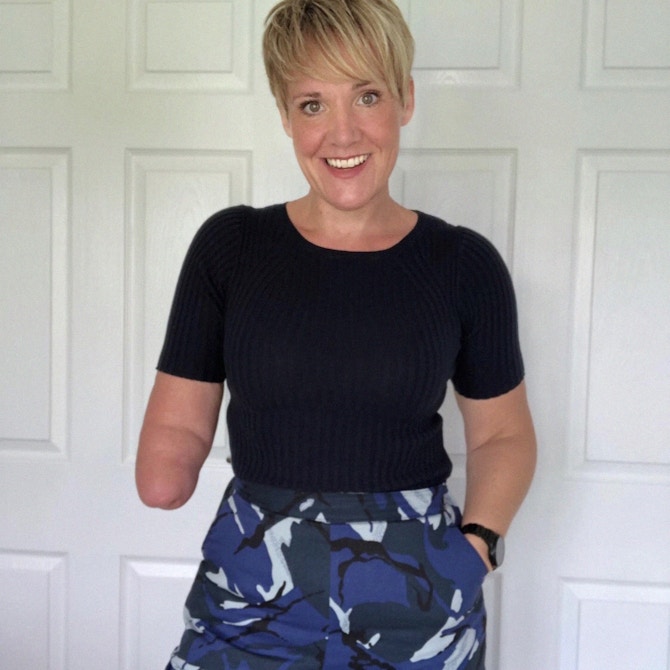
Gill Thomas
22—July 2023
July is Disability Pride Month, a time to recognise all kinds of disabilities and understand the wide range of support that disabled folks need to thrive. We catch up with UK-based sewist Gill Thomas @theonearmedsewist this week to chat about her sewing journey!
Many of you will be familiar with UK-based Gill Thomas from The Great British Sewing Bee and her instagram @theonearmedsewist. We love the way Gill openly shares her sewing journey as a genuine and positive advocate for limb different folks. This week we chat to Gill about all things sewing, including her projects past and present.
Hello!! I’m Gill and I’m a self-confessed sewing addict, I just love creating and making things, so much so that in 2022 I ended up on the TV show The Great British Sewing Bee. I’m also a public speaker, sewing tutor and runner and I’m based in Yorkshire in the UK. I’m sometimes known as The One Armed Sewist, because I have an upper limb difference – that means I don’t have a right forearm, hand or fingers, so I sew everything with one arm.
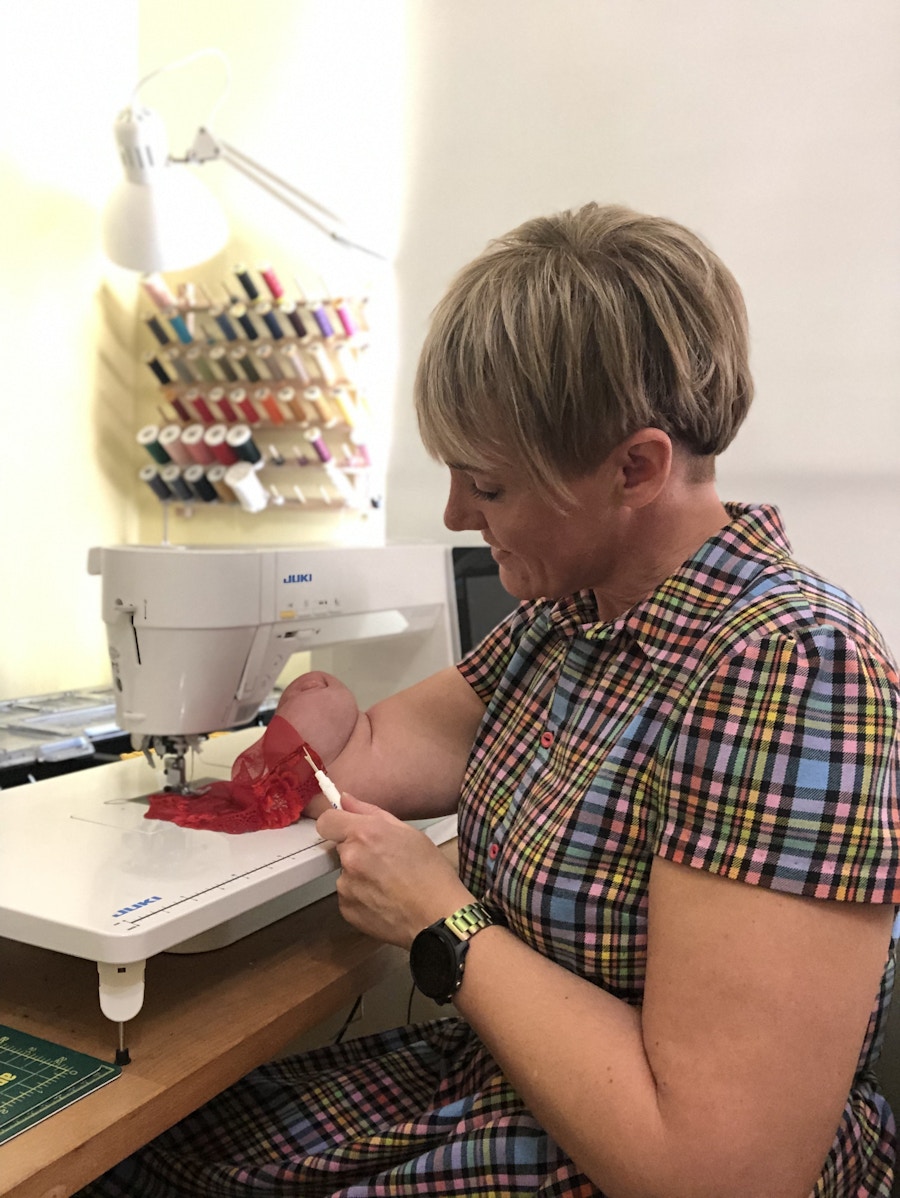
From being a little girl, I’ve been fascinated by dressmaking; my great-grandmother Ivy used to make clothes for herself and all the family. I loved sitting with her and looking at old photos of her and my great-grandfather, wearing clothes that she’d made. Unfortunately, she passed away before she got the chance to teach me how to sew, but she had lit the fire in my belly of wanting to learn.
As I got older, I found it harder and harder to find clothing to fit me on the high street. Like many people, my body shape isn’t “standard”, and every time I tried clothes on in a shop that didn’t fit, my confidence got knocked. Negative thoughts and feelings about my body shape and size were constantly being reinforced by the clothing that was available to buy.
I often thought about my great-grandmother and how if she was alive, she’d be able to help me adjust clothes to fit my body shape or teach me how to sew. But she wasn’t around, and without her I didn’t know where to start. I didn’t know if it would be physically possible to use a sewing machine with one arm. At that time, I didn’t know anyone else with a limb difference, so it wasn’t like I could ring my one-armed friends up to ask them how it might work.
In September 2018 I went clothes shopping, I needed some trousers for a work event with a strict dress code. I tried on what felt like hundreds of trousers, in different sizes and styles, in every shop I could find. Not one pair came close to fitting me, the difference between my hips and waist was so much bigger than any of the trousers in the shops. I came home in tears, I hated my body and blamed myself for not being able to get clothes that fitted me. I felt like I was unattractive and abnormal, and that I needed to do everything I could to change my body. My husband Darren was a voice of reason, he kept telling me that this wasn’t true, and he reminded me again about my great-grandmother and he suggested I learn to sew.
I took the plunge and bought a sewing machine; I didn’t have a clue how to use it or where to start! So, I bought a book aimed at beginners, it guided me through the very basics, like what a bobbin is and how to thread the machine and it did that by taking me through different projects.
The first thing I ever made was a headscarf and as soon as I’d made that I was hooked! And here we are almost 5 years later, sewing has become such an important and integral part of my life.
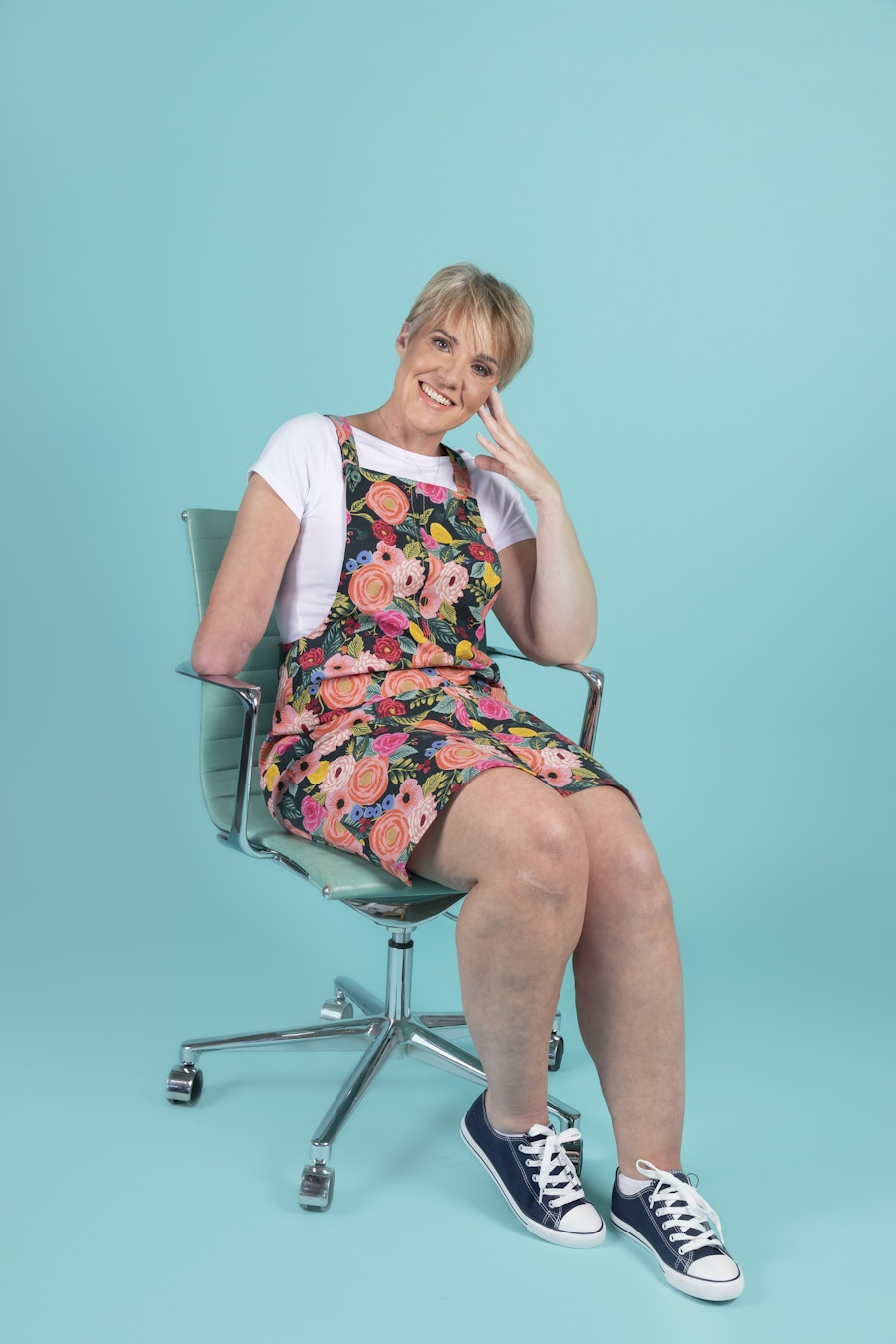
Sewing brings me so much joy, one of the main reasons for this is that I can make clothes that fit me, and it makes me feel amazing when I wear them. Learning to sew is like discovering the keys to a new world, a world where negative thoughts about my body aren’t reinforced by an elusive industry standard. It’s a world where I can choose exactly what I want, and create something that fits my body perfectly, that makes me feel empowered and confident. It’s a world where I can choose the type of opening to have on a garment, and where to place it, so I can get dressed easily using one arm. It’s a world where I can get support and learn from other people who sew. It’s a world where it feels like there aren’t any limits, and it’s glorious.
For me sewing has changed everything, it’s given me the confidence to embrace who I am, to know that my body is perfect, just the way that it is. It’s given me the confidence to try new things and to challenge myself to do things I never thought I could before, and of course it’s given me the gift of wearing amazing clothes and looking fabulous while I do all that.
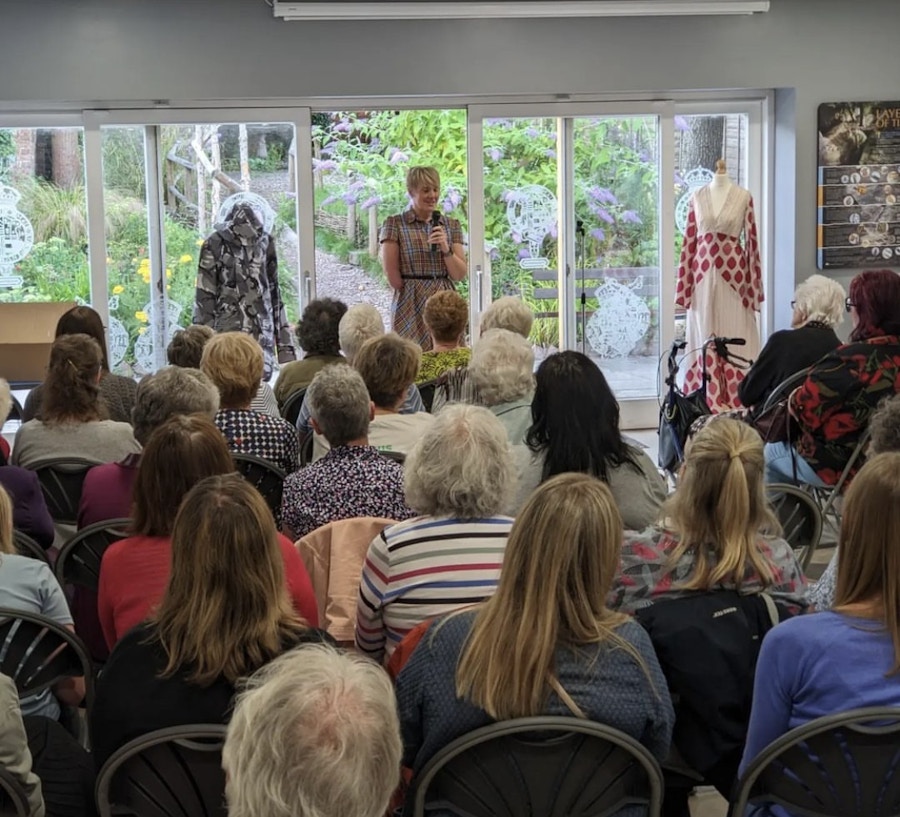
This is a really easy question for me to answer, without a doubt my favourite wardrobe item has got to be trousers. Any trousers that I’ve made – because of course they fit me – and I have some fabulous ones in my wardrobe (including some Cass Pants that I LOVE), and it all started with that disastrous shopping trip in September 2018, where I was desperately trying to find some trousers and I ended up in tears.
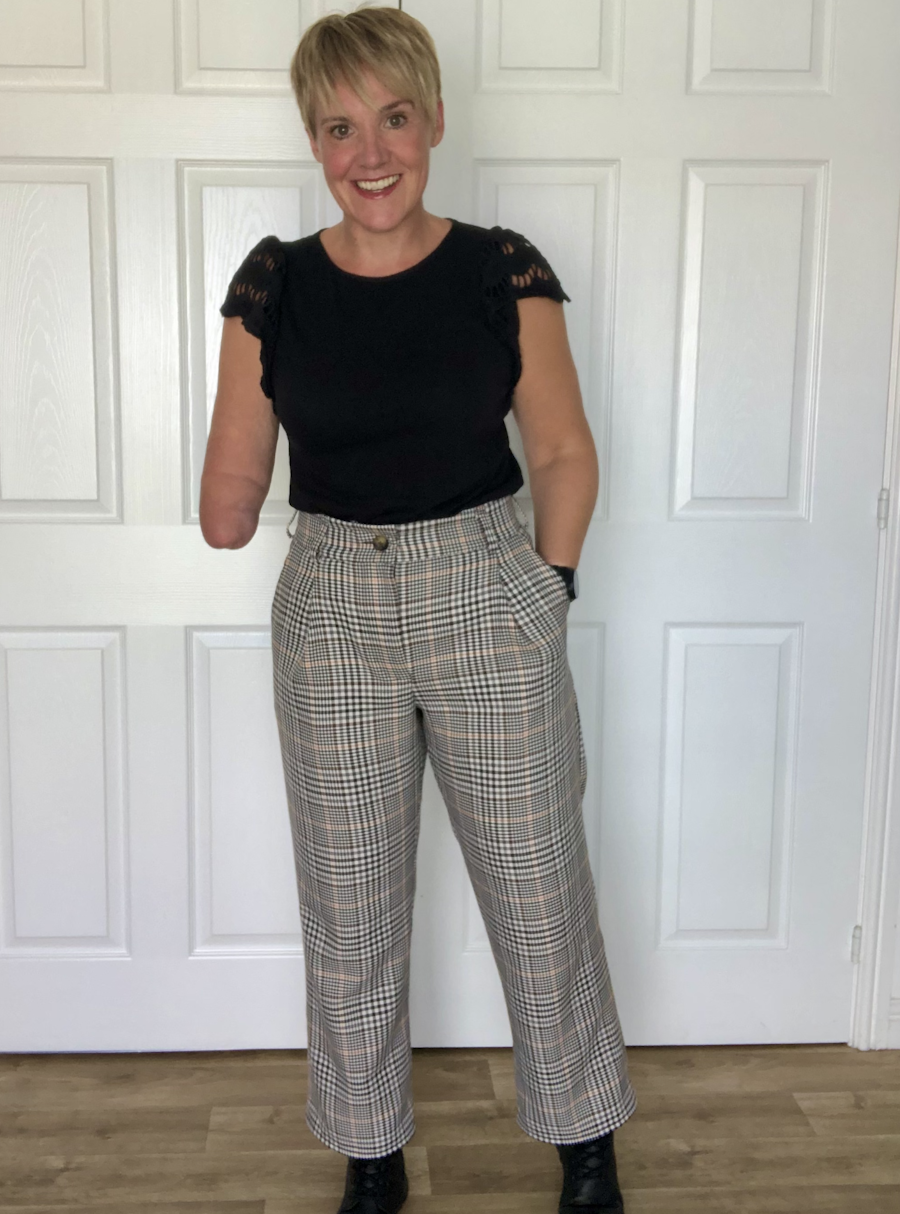
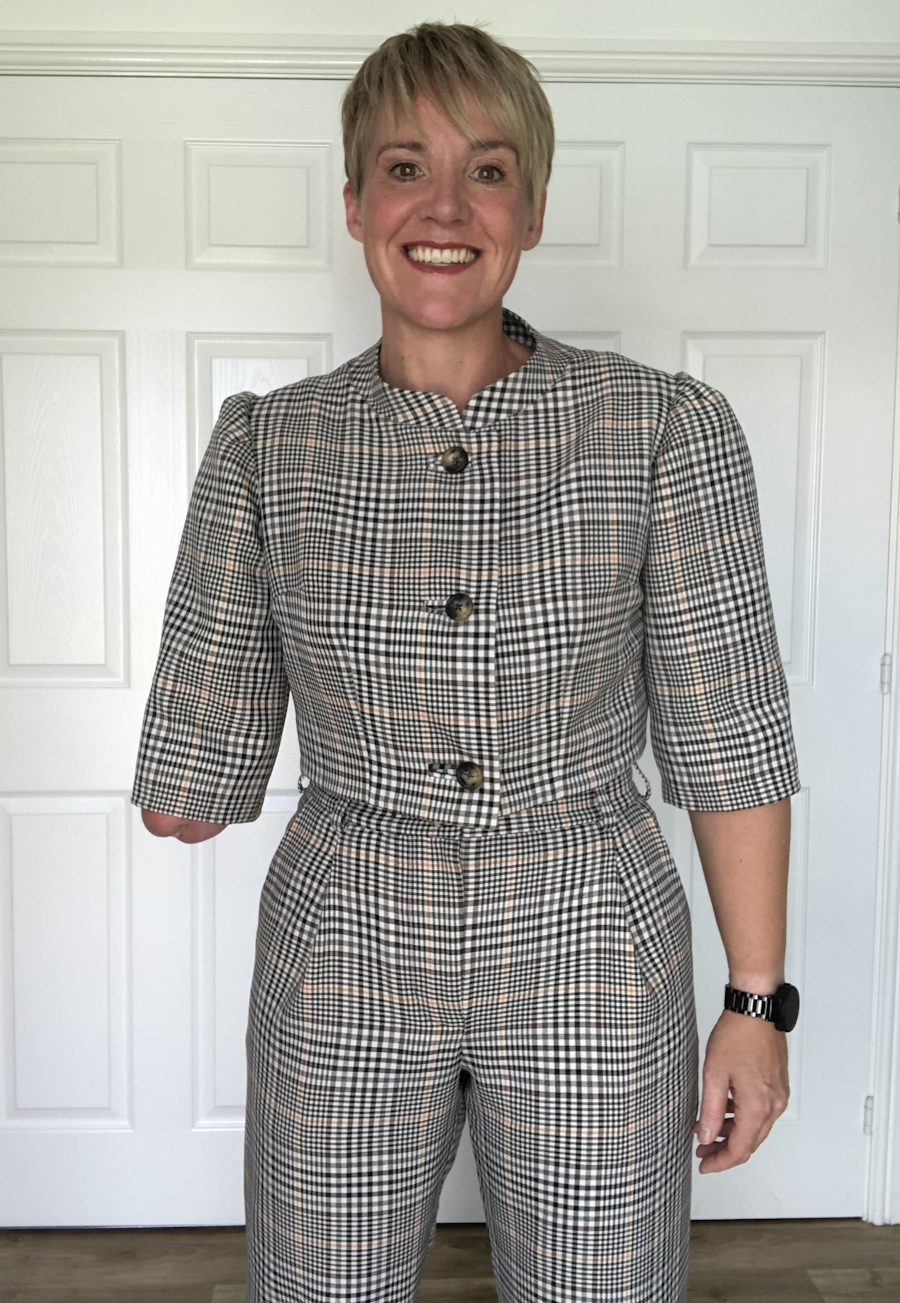
I’ve recently started making my own bras. This was something I found the thought of overwhelming, but with some support from fellow makers, I’ve found it such an enjoyable experience. The seam allowances on bras are small and there’s very little room for error, this has made me slow down and take my time and I find myself getting lost in the process. So, I’m working on a bra at the moment, and then I’ve got a few more in the pipeline too!
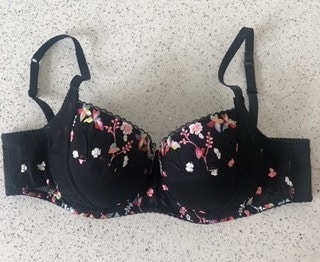
My biggest sewing success has got to be the first thing I ever made – a simple head scarf. Although this was an easy thing to make, at the time it felt impossible. I’d never touched a sewing machine, so in making the headscarf I had to do a lot of firsts, there was so much learning involved; like what a bobbin is, how to thread a machine, how to cut fabric out, what seam allowances are, wrong sides and right sides of fabric, and sewing stitches in a straight line. All these were completely new to me, so my biggest sewing success taught me that if you take your time and do things step by step, anything is possible – even if you really don’t know what you’re doing.
Sewing flops can turn out to be good things, but they can be so hard to deal with at the time. Whenever I make something, I get emotionally attached to it, understandably because I’ve spent a lot of time and energy creating it! So, when it’s a flop it hurts. My biggest flop was an attempt at making a dress, I’d got some gorgeous fabric that cost me a lot to buy and, in my head, I had a vision. I found a pattern that looked like what I had in mind, but I’d never used a pattern by that brand before or made a dress quite like it. I was short on time because I wanted this dress for a specific event. I made the mistake of just going for it, I cut the pattern out based on my measurements, but didn’t take time to really compare the finished measurements to my own measurements, I cut my lovely fabric and sewed it together. I was so excited doing this because I was working with gorgeous fabric, I was going to get it done in time for the event and I had a very clear picture of what it was going to look like in my head. Once I’d made it, I tried it on and was devastated. It didn’t fit and it didn’t look good on me – it did not look like the picture in my mind!
There was no way of saving the dress, any changes I tried to make it fit better just didn’t work. I’d wasted a lot of time and some beautiful fabric because I’d rushed. Skipping the steps at the beginning of a project can be tempting, we all want to get to the fun bit right. But, taking time to look at the pattern and consider how the finished measurements relate to your body is definitely worth doing, as is making a toile if it’s something you’ve never made before or if you haven’t used that brand before.
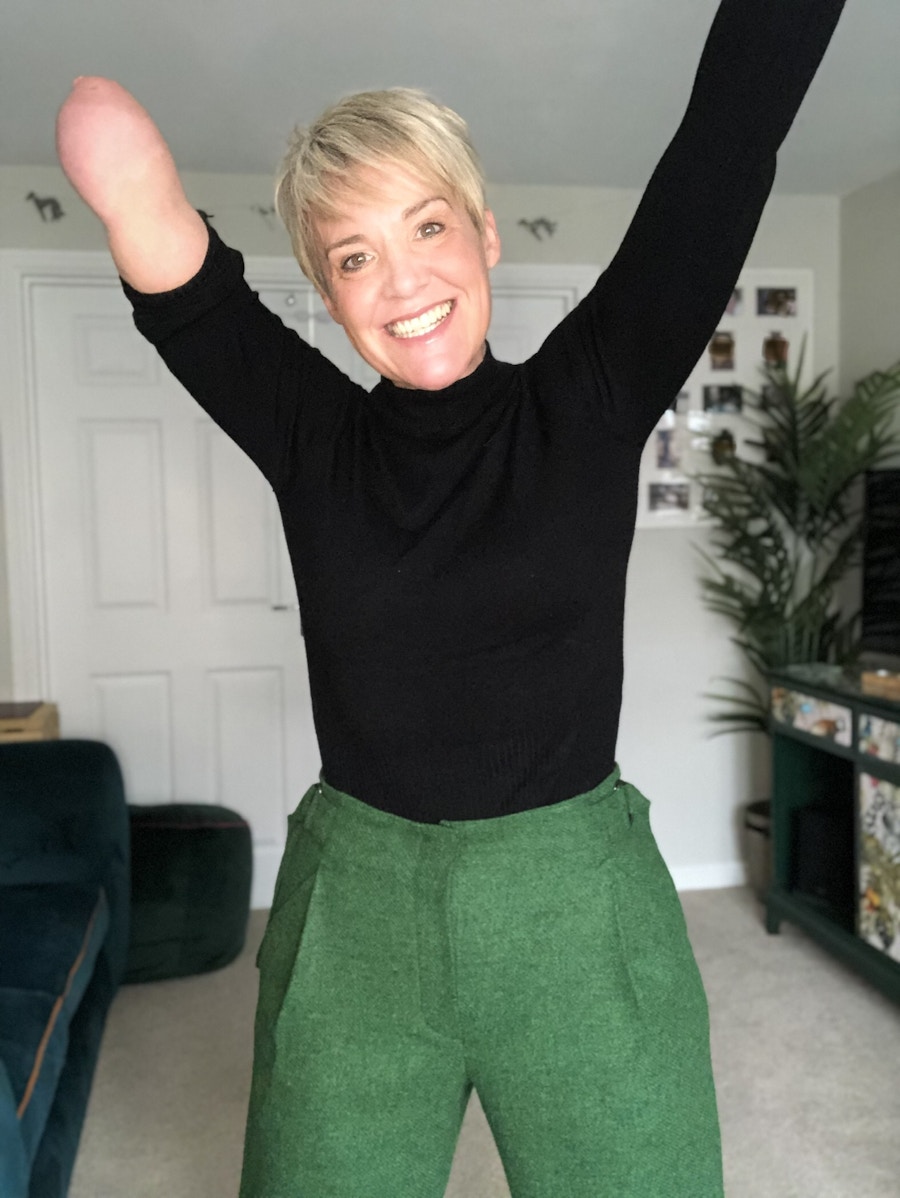
My number one sewing tip is to keep your mistakes or any imperfections in what you’ve made to yourself. It can be easy to focus on the things we don’t think we got quite right and lose sight of all the amazing things we did do right. Other people won’t see the imperfections in the same way we do, so don’t tell them about them! If anyone compliments what you’ve made, accept the compliment, don’t say “Thank you but…….” and then list everything you aren’t happy with. This isn’t about keeping mistakes a secret, or pretending to be something you aren’t, it’s about allowing compliments to land, and acknowledging everything else we achieve.
Disability Pride Month holds a special place in my heart. For a long time, I didn’t acknowledge my limb difference or that I have a disability, or allow myself to understand that sometimes my needs are different to other peoples because of it. I didn’t realise that this was making my life smaller, and at times a lot harder. By seeing other people practicing Disability Pride Month it helped me learn that there’s nothing wrong with being disabled, and that I don’t have to accept discrimination; I don’t owe my story or medical history to anyone, and I don’t need to accept a situation just to avoid awkwardness or to be polite. I deserve to take up space and I deserve to be treated equitably.
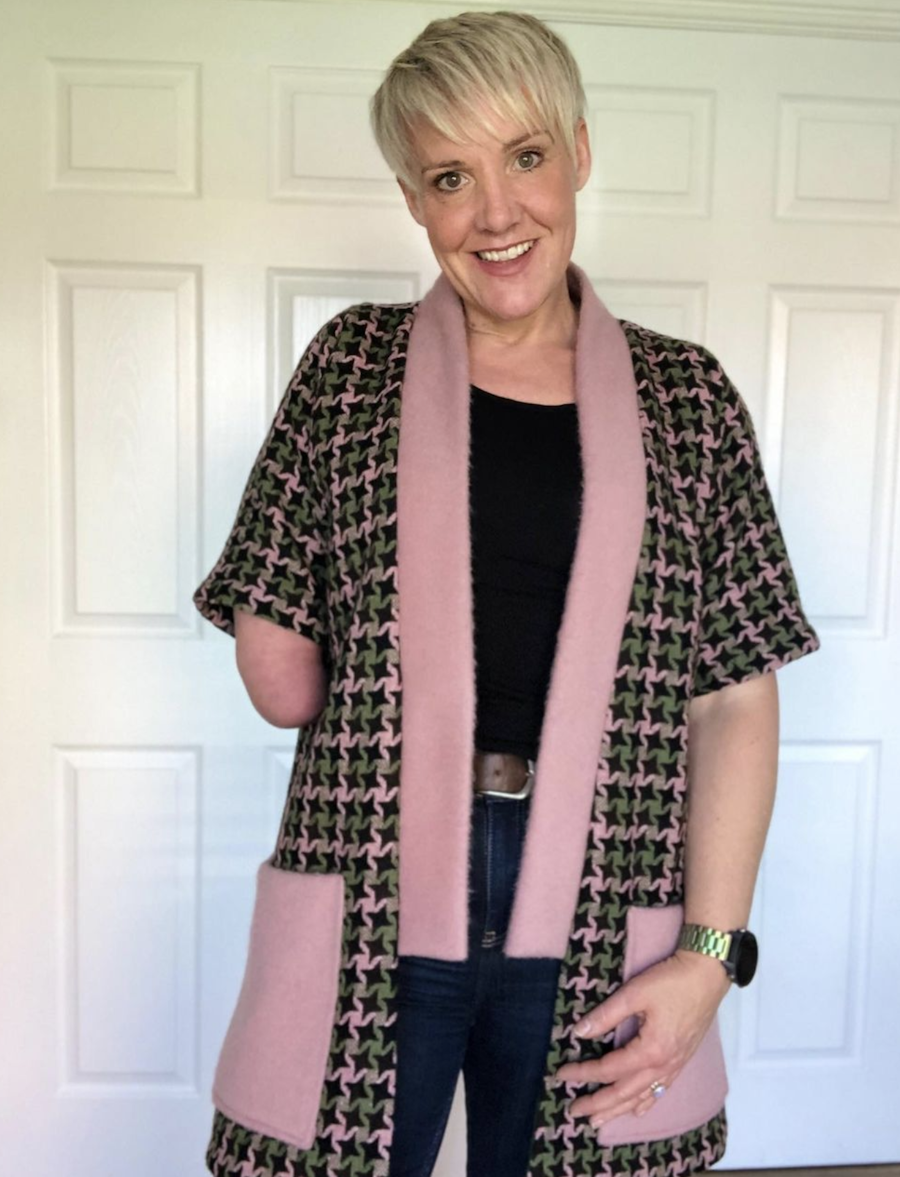
When I first started sewing, I wasn’t aware there are features available on sewing machines that can make sewing much more accessible. I just bought a sewing machine that had good reviews and that I could afford. This meant I spent a lot of time doing things the best way that I could but finding them quite hard to do!
I was using a machine where you had to manually lift and lower the presser foot by pressing a lever that was positioned at the back of the machine on the right side, so I could only reach it with my stump, this meant I had to stretch and try and reach it while holding my fabric in place with my left hand.
The button for the reverse/back stitch was positioned on the front of the machine, but next to other buttons, again on the right side. So, I used to try and press the button with my stump, without accidentally hitting any of the other buttons. I got pretty good at this, but I did used to hit the wrong buttons by accident and end up triggering a function I really didn’t want.
If I was using fabrics that weren’t feeding through the machine evenly and I needed to use a walking/dual feed foot, it was super fiddly to change to this foot on my old machine – requiring a screwdriver and I think three hands, not just two!
A chance conversation with someone who sews made me realise there are features on a sewing machine that can make sewing a lot easier for me. I’ve now got a machine that has a dual foot pedal, I can programme it so the second pedal does a back stitch, or can cut the threads, or can do both! It’s got a knee lever, so I can lift the presser foot by using my knee. It’s got a walking/dual feed foot that can be activated by flicking a switch, so I don’t need to spend 30 minutes trying to change the foot one handed. All these things mean that sewing is made so much easier, because the machine does the things that I used to struggle to do physically.
There are a couple of things I still find difficult and try to avoid, like hand sewing or using pins. Luckily there are usually alternative options available, but if I do find I need to do either of these, then I just take my time and do it, in my own way.
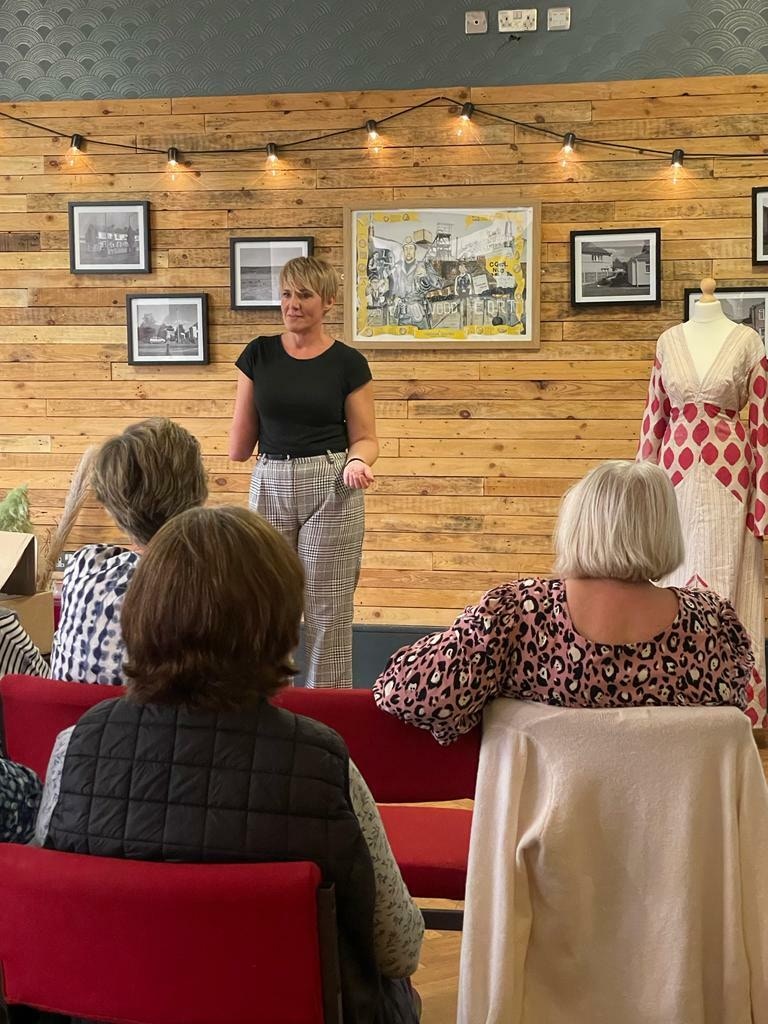
I’ve personally found the sewing community incredibly supportive; I’ve made so many great connections and learnt so much and I feel they are an important part of my sewing journey. The main reason for this is because many people are respectful; they don’t ask intrusive questions about my medical history (what happened to me), they don’t offer unsolicited advice, they don’t assume I need help, they don’t assume they know of a better way of doing things and they don’t assume they can understand what it’s like living with a disability, if they don’t have their own lived experience of it. If anyone does have a suggestion or an idea, it’s great if they ask me if I would like to hear about it, and listen to my answer, before they share it.
Another way the community could be supportive and inclusive would be to offer more options with designs and patterns. Including different options for the placement of openings and closures or including options for different types of fastenings. An example would be zip placement, when they are on the back of a garment, I can’t use these one handed (for anyone wondering why, have a go using only one hand), I change the placement of zips to the left side or front of a garment, so I can dress independently. It would be amazing if other placement options were offered as it would make things more inclusive, not just for people with a limb difference.

A lot of my inspiration comes from films and TV shows, I often see things I like, then my imagination takes over and I find myself daydreaming about how I’m going to create my version of that. I particularly love period and vintage fashion; a two-piece set I made where I used the Cass Pants was inspired by the TV show The Marvellous Mrs Maisel.
I also get inspiration from the sewing community on Instagram. I find hand sewing and pinning garments challenging because of my limb difference. The community on Instagram helped inspire me to create a stump thimble. This is a game changer for me; I can now pin, and hand sew things a little more easily, without hurting myself and it’s all thanks to the inspiration from that lovely community.
My all-time favourite sewing related book is from Tilly and The Buttons, I taught myself to sew using the book “Love at First Stitch”, before that I’d never touched a sewing machine and Tilly’s book guided me through everything, I needed to know to be able to make clothes.
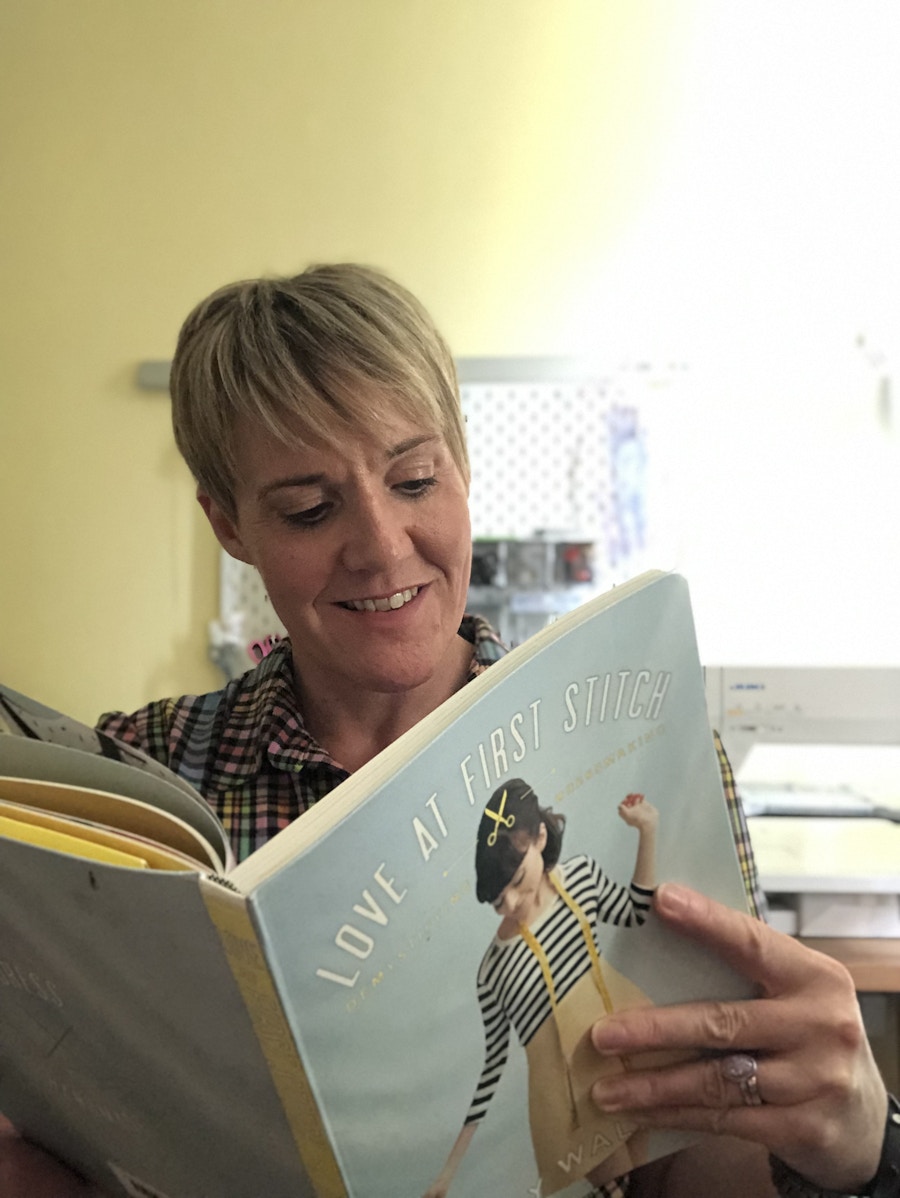
A huge thank you to Gill for chatting with us this week, we can't wait to see the new projects she's working on come to life!
We hope you've enjoyed this Friend of TFS interview. Head over and follow Gill via Instagram or check out her blog for more!